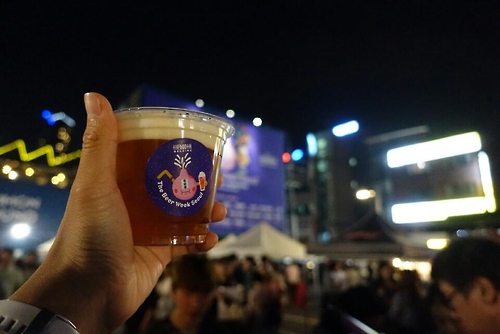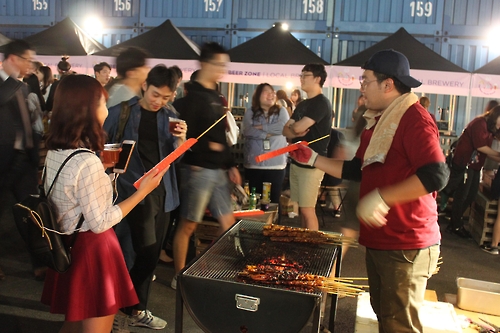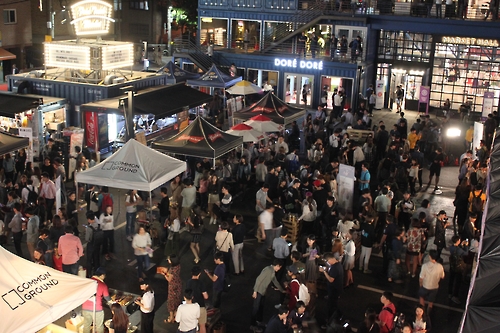- California Assembly OKs highest minimum wage in nation
- S. Korea unveils first graphic cigarette warnings
- US joins with South Korea, Japan in bid to deter North Korea
- LPGA golfer Chun In-gee finally back in action
- S. Korea won’t be top seed in final World Cup qualification round
- US men’s soccer misses 2nd straight Olympics
- US back on track in qualifying with 4-0 win over Guatemala
- High-intensity workout injuries spawn cottage industry
- CDC expands range of Zika mosquitoes into parts of Northeast
- Who knew? ‘The Walking Dead’ is helping families connect
Taedonggang Beer? What about S. Korea’s craft beer?
SEOUL, Sept. 23 (Yonhap) — Four years after creating a stir in South Korea by writing in The Economist magazine that the country’s beer was dull and even inferior to North Korea’s Taedonggang Beer, Daniel Tudor admits things have changed a lot.
“The standard across the industry is definitely getting better,” he said.
The former Seoul correspondent for The Economist, who co-founded a chain of craft beer pubs here in 2014, said beer can be a major export item for South Korea helped by the unrelenting popularity of K-culture abroad, known as the Korean wave or hallyu.
“In the long run, I’d like to suggest making (South) Korean beer into a hallyu lifestyle product. Beer is actually a huge industry, and Korea needs new export opportunities more than ever, so why not?” Tudor said in an email interview from Britain. “Anyway, I think regardless of policy, the change will continue. The most important thing is that Korean beer drinkers have been shown a better alternative, and so over time, more and more will demand tasty beer.”
His article “Fiery food, boring beer” has obviously put some fizz into South Korea’s beer industry long dominated by a duopoly by Goliath brewers Hite Jinro and Oriental Brewery (OB).
Consumers vented their pent-up desire for various types of higher quality beer, leading the government to revise regulations in 2014 to allow smaller breweries here to produce and distribute their own products.
More than 60 boozers nationwide, including those outside the Itaewon and Hongdae areas, specialize in serving local and imported craft beer.
The domestic craft brewing industry is still in the nascent stage, accounting for 0.5-1 percent of the entire beer market worth around 2.2 trillion won (US$2 billion) last year, according to official data. But it’s expected to jump to as high as 10 percent in the next five years.
“Factory beer is no match to craft beer at all,” Lee Hye-won, an office worker who describes herself as a craft brew geek, said. “I like this special flavor derived from more hops and diversity based on different and innovative recipes.”
Craft beer, she added, is “for savoring, not for swilling,” a totally different world from ordinary beer often used for mixed drinks, or boilermakers (poktanju in Korean).
Lee, a resident of Bundang, Gyeonggi Province, joined the Beer Week Seoul festival, a rare craft beer-only event here, along with hundreds of other craft beer lovers including many foreigners.
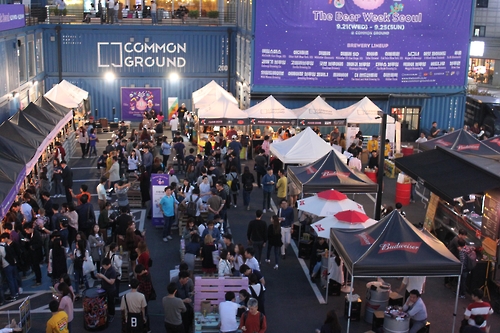
Craft beer lovers crowd the Common Ground mall in eastern Seoul, the venue for the Beer Week Seoul fete, on Sept. 21, 2016.
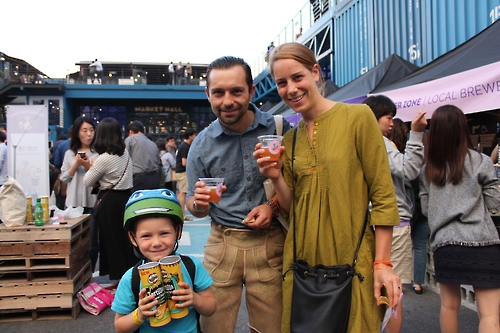
The German globe-trotting family of Arne Franz enjoys the Beer Week Seoul festival at Common Ground near Konkuk University on Sept. 21, 2016.
The event opened Wednesday evening for a five-day run at Common Ground near Konkuk University in eastern Seoul.
Organized by the Booth Brewing Co., a leading South Korean craft beer startup co-established by Tudor, it showcases 65 kinds of specialty, seasonal and small batch craft beer made by two dozen local and foreign brewers. Each cup of beer is priced at 5,500 won for local brands and 6,500 won for foreign ones. Also in the lineup are San Diego’s AleSmith IPA and New York-based Other Half Brewing’s products, which are not marketed in South Korea.
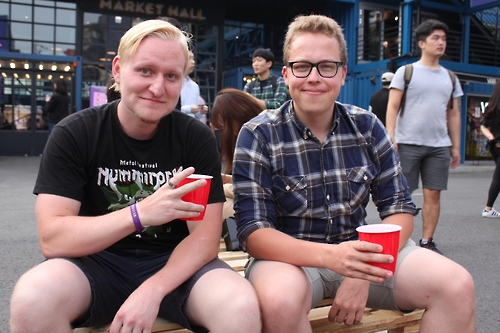
Alexsi Toivonien (R) and Teemu Lahtinen, students from Finland who are studying at Konkuk University, pose for a photo during the Beer Week Seoul festival on Sept. 21, 2016.
“Good beer, good food and good friend here,” said Aleksi Toivonien, an exchange college student from Finland. Nice autumn weather and live music are a bonus.
His friend Teemu Lahtinen, also from Finland and studying at Konkuk University, quipped, “I have not tried Taedonggang Beer yet. But I’ve done a lot of European beers. As a beer veteran, I think South Korean beer is very good.”
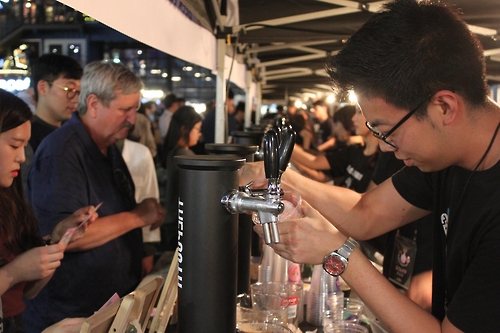
Dan Brousseau from Chicago (L) is waiting for a cup of craft beer, joining the Beer Week Seoul event on Sept. 21, 2016.
Dan Brousseau, an elderly Chicago man, has become a fan of South Korean craft beer as well.
“My only recommendation is to add flavor, I mean a stronger flavor,” he said, enjoying a local brand named Kukmin IPA. “I also had Inseng IPA. It was great too. If it’s on sale in the U.S., I will buy it.”
He is traveling in South Korea with his wife Terri, while visiting their son who teaches English.
In fact, the Booth Brewing, South Korea’s front-running craft beer maker, is taking the initiative. It recently took over a brewery in California in a bid to tap into the U.S. market.
“We plan to begin full-scale production there late this year,” said Kim Hee-yoon, the Booth’s chief marketing officer. “The U.S. is a mecca for craft beer makers and other microbrewers. It’s a challenging task but we want to give it a try.”
Craft beer has already altered her career.
Two years ago, she teamed up with Tudor to open the first Booth pub in Itaewon, while working as an oriental medicine doctor. As the business prospered more than Kim expected, she quit her original job.
Calling herself a “festivalist,” she believes craft beer makes life much more tastier and hopes to share that joy with other people.
“South Korea’s drinking culture is changing as is beer consumers’ preference,” Kim said. “Craft brewing is quite promising as people will keep looking for something new and different, just like specialty coffee.”
The Beer Week Seoul fete is part of efforts to promote the charm of craft beer.
The inaugural event, held in April, drew around 7,000 people, with more than 12,000 visitors expected this time, according to Kim.
Ronn Branton, a jazz musician from Washington D.C., agreed that South Korea has great potential in the field. He’s keenly interested in craft brews and involved in a related business in “addition” to his musical activities.
“Korean brewers are improving. They are getting better and better,” he said. “A few years ago, most of the production laws favored chaebol (local conglomerates). In other words, only you could produce massive quantities at the chaebol level and could sell beer. But it’s changing. And as a result, there are more Korean brewers that are getting better and better.”
Craft brewers here, he noted, need to resolve the practical problem of logistics and distribution networks, for example importing ingredients they need and meeting regulations.
“But given what’s going on, they, especially hidden-track guys producing unique ale, will be able to equal the skills that you find in America now,” he said. “In terms of craft beer, North Korea can’t compete (with South Korea). To my knowledge, I don’t think they’ve been experimenting (with new beer).”







